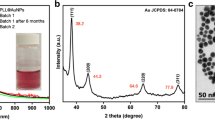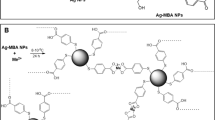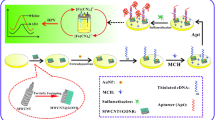Abstract
A surface-enhanced Raman scattering nanoprobe has been developed for sulfide detection and applied to complex bacterial biofilms. The nanoprobe, Au@4-MBN@Ag@ZIF-8, comprised a gold core modified with 4-mercaptobenzonitrile (4-MBN) as signaling source, a layer of silver shell as the sulfide sensitization material, and a zeolitic imidazolate framework-8 (ZIF-8) as surface barrier. ZIF-8, with its high surface area and mesoporous structure, was applied to preconcentrate sulfide around the nanoprobe with its excellent adsorption capacity. Besides, the external wrapping of ZIF-8 can not only prevent the interference of biomolecules, such as proteins, with the Au@4-MBN@Ag assay but also enhance the detection specificity through the sulfide cleavage function towards ZIF-8. These properties are critical for the application of this nanoprobe to complex environmental scenarios. In the presence of sulfide, it was first enriched through adsorption by the outer ZIF-8 layer, then destroyed the barrier layer, and subsequently reacted with the Ag shell, leading to changes in the Raman signal. Through this rational design, the Au@4-MBN@Ag@ZIF-8 nanoprobe exhibited excellent detection sensitivity, with a sulfide detection limit in the nanomolar range and strong linearity in the concentration range 50 nM to 500 μM. Furthermore, the proposed Au@4-MBN@Ag@ZIF-8 nanoprobe was effectively utilized for sulfide detection in intricate biofilm matrices, demonstrating its robust selectivity and reproducibility.
Graphical Abstract









Similar content being viewed by others

References
Wen H, Yan J, Wu L, Chang X, Ye W, Zhang H, Huang L, Xiao T (2023) Desulfurization of hydrophilic and hydrophobic volatile reduced sulfur with elemental sulfur production in denitrifying bioscrubber. Chemosphere 316:137806–137815
Shao Y, Chen Z, Wu L (2019) Oxidative stress effects of soluble sulfide on human hepatocyte cell line LO2. Int J Environ Res Public Health 16:1–11
Fukuoka H, Andou T, Moriya T, Narita K, Kasahara K, Miura D, Sekiguchi Y, Suzuki S, Nakagawa K, Ozawa M, Ishibe A, Endo I (2021) Sulphur metabolism in colon cancer tissues: a case report and literature review. J Int Med Res 49:1–9
Chen W, Ni D, Rosenkrans ZT, Cao T, Cai W (2019) Smart H2S-triggered/therapeutic system (SHTS)-based nanomedicine, Advanced. Science 6:1901724–1901750
Zhang Y, Yue T, Gu W, Liu A, Cheng M, Zheng H, Bao D, Li F, Piao JG (2022) pH-responsive hierarchical H(2)S-releasing nano-disinfectant with deep-penetrating and anti-inflammatory properties for synergistically enhanced eradication of bacterial biofilms and wound infection. J Nanobiotechnology 20:55–72
Chen YH, Teng X, Hu ZJ, Tian DY, Jin S, Wu YM (2021) Hydrogen sulfide attenuated sepsis-induced myocardial dysfunction through TLR4 pathway and endoplasmic reticulum stress. Front Physiol 12:653601–653611
Litti L, Trivini S, Ferraro D, Reguera J (2021) 3D printed microfluidic device for magnetic trapping and SERS quantitative evaluation of environmental and biomedical analytes. ACS Appl Mater Interfaces 13:34752–34761
Ghadiri M, Kariminia HR, Roosta Azad R (2013) Spectrophotometric determination of sulfide based on peroxidase inhibition by detection of purpurogallin formation. Ecotoxicol Environ Saf 91:117–121
El-Maghrabey MH, Watanabe R, Kishikawa N, Kuroda N (2019) Detection of hydrogen sulfide in water samples with 2-(4-hydroxyphenyl)-4,5-di(2-pyridyl)imidazole-copper(II) complex using environmentally green microplate fluorescence assay method. Anal Chim Acta 1057:123–131
Jiang Y, Sun D-W, Pu H, Wei Q (2018) Surface enhanced Raman spectroscopy (SERS): a novel reliable technique for rapid detection of common harmful chemical residues. Trends Food Sci Technol 75:10–22
Wang Y, Zhang D, Sun Y, Zeng Y, Qi P (2023) Precise localization and simultaneous bacterial eradication of biofilms based on nanocontainers with successive responsive property toward pH and ATP. ACS Appl Mater Interfaces 15:8424–8435
Buret AG, Allain T, Motta J-P, Wallace JL (2022) Effects of hydrogen sulfide on the microbiome: from toxicity to therapy. Antioxid Redox Signal 36:211–219
Washio J, Sato T, Koseki T, Takahashi N (2005) Hydrogen sulfide-producing bacteria in tongue biofilm and their relationship with oral malodour. J Med Microbiol 54:889–895
Wang W, Ma P, Song D (2022) Applications of surface-enhanced Raman spectroscopy based on portable Raman spectrometers: a review of recent developments. Luminescence 37:1822–1835
Zhu A, Ali S, Jiao T, Wang Z, Ouyang Q, Chen Q (2023) Advances in surface-enhanced Raman spectroscopy technology for detection of foodborne pathogens. Compr Rev Food Sci Food Saf 1466-1494
Wang C, Wang C, Li J, Tu Z, Gu B, Wang S (2022) Ultrasensitive and multiplex detection of four pathogenic bacteria on a bi-channel lateral flow immunoassay strip with three-dimensional membrane-like SERS nanostickers. Biosens Bioelectron 214:114525–114534
Li Y, Xin X, Zhang T, Li W, Li J, Lu R (2021) Raspberry-like polyamide@Ag hybrid nanoarrays with flexible cores and SERS signal enhancement strategy for adenosine detection. Chem Eng J 422:129983–129993
Yang D, Li H, Li Q, Li K, Xiao F, Yang Y (2022) Highly selective histamine assay via SERS: based on the signal enhancement of carbon dots and the fluorescence quenching of gold nanoparticles. Sens Actuators, B Chem 350:130866–130872
Huang Y-H, Wei H, Santiago PJ, Thrift WJ, Ragan R, Jiang S (2023) Sensing antibiotics in wastewater using surface-enhanced Raman scattering. Environ Sci Technol 57:4880–4891
Kang S, Wang W, Rahman A, Nam W, Zhou W, Vikesland PJ (2022) Highly porous gold supraparticles as surface-enhanced Raman spectroscopy (SERS) substrates for sensitive detection of environmental contaminants. RSC Adv 12:32803–32812
Zhang WS, Wang YN, Xu ZR (2020) High sensitivity and non-background SERS detection of endogenous hydrogen sulfide in living cells using core-shell nanoparticles. Anal Chim Acta 1094:106–112
Fu JH, Zhong Z, Xie D, Guo YJ, Kong DX, Zhao ZX, Zhao ZX, Li M (2020) SERS-active MIL-100(Fe) sensory array for ultrasensitive and multiplex detection of VOCs. Angew Chem Int Ed 59:20489–20498
Rickard JJS, Di-Pietro V, Smith DJ, Davies DJ, Belli A, Oppenheimer PG (2020) Rapid optofluidic detection of biomarkers for traumatic brain injury via surface-enhanced Raman spectroscopy, Nature. Biomed Eng 4:610–623
Qiao X, Su B, Liu C, Song Q, Luo D, Mo G, Wang T (2017) Selective surface enhanced Raman scattering for quantitative detection of lung cancer biomarkers in superparticle@MOF structure. Adv Mater 30:1702275–1702282
Hu Y, Liao J, Wang D, Li G (2014) Fabrication of gold nanoparticle-embedded metal-organic framework for highly sensitive surface-enhanced Raman scattering detection. Anal Chem 86:3955–3963
Li D, Cao X, Zhang Q, Ren X, Jiang L, Li D, Deng W, Liu H (2019) Facile in situ synthesis of core–shell MOF@Ag nanoparticle composites on screen-printed electrodes for ultrasensitive SERS detection of polycyclic aromatic hydrocarbons. J Mater Chem A 7:14108–14117
Kim H, Jang H, Moon J, Byun J, Jeong J, Jung J, Lim EK, Kang T (2019) Metal-organic framework coating for the preservation of silver nanowire surface-enhanced Raman scattering platform. Adv Mater Interfaces 6:1900427-1900435
Yu T-H, Ho C-H, Wu C-Y, Chien C-H, Lin C-H, Lee S (2013) Metal-organic frameworks: a novel SERS substrate. J Raman Spectrosc 44:1506–1511
Pipelzadeh E, Rudolph V, Hanson G, Noble C, Wang L (2017) Photoreduction of CO2 on ZIF-8/TiO2 nanocomposites in a gaseous photoreactor under pressure swing. Appl Catal B 218:672–678
Zhou X, Liu G, Zhang H, Li Y, Cai W (2019) Porous zeolite imidazole framework-wrapped urchin-like Au-Ag nanocrystals for SERS detection of trace hexachlorocyclohexane pesticides via efficient enrichment. J Hazard Mater 368:429–435
Lai H, Li G, Xu F, Zhang Z (2020) Metal–organic frameworks: opportunities and challenges for surface-enhanced Raman scattering — a review. J Mater Chem C 8:2952–2963
Li M, Cushing SK, Zhou G, Wu N (2020) Molecular hot spots in surface-enhanced Raman scattering. Nanoscale 12:22036–22041
Man T, Lai W, Xiao M, Wang X, Chandrasekaran AR, Pei H, Li L (2020) A versatile biomolecular detection platform based on photo-induced enhanced Raman spectroscopy. Biosens Bioelectron 147:111742–111771
Taheri M, Tsuzuki T (2021) Photo-accelerated hydrolysis of metal organic framework ZIF-8. ACS Mater Lett 3:255–260
Yuan A, Hao C, Wu X, Sun M, Qu A, Xu L, Kuang H, Xu C (2020) Chiral Cu(x) OS@ZIF-8 nanostructures for ultrasensitive quantification of hydrogen sulfide in vivo. Adv Mater 32:e1906580
Rajendran J (2023) Amperometric determination of salivary thiocyanate using electrochemically fabricated poly (3, 4-ethylenedioxythiophene)/MXene hybrid film. J Hazard Mater 449:130979
Funding
This work is financially supported by the National Natural Science Foundation of China (grant numbers: 42376208 and 41922040) and 0)the Natural Science Foundation Project of Shandong Province (No.: ZR2020ME009).
Author information
Authors and Affiliations
Corresponding authors
Ethics declarations
Conflict of interest
The authors declare no competing interests.
Additional information
Publisher's Note
Springer Nature remains neutral with regard to jurisdictional claims in published maps and institutional affiliations.
Supplementary Information
Below is the link to the electronic supplementary material.
Rights and permissions
Springer Nature or its licensor (e.g. a society or other partner) holds exclusive rights to this article under a publishing agreement with the author(s) or other rightsholder(s); author self-archiving of the accepted manuscript version of this article is solely governed by the terms of such publishing agreement and applicable law.
About this article
Cite this article
He, J., Qi, P., Zhang, D. et al. Determination of sulfide in complex biofilm matrices using silver-coated, 4-mercaptobenzonitrile-modified gold nanoparticles, encapsulated in ZIF-8 as surface-enhanced Raman scattering nanoprobe. Microchim Acta 190, 475 (2023). https://doi.org/10.1007/s00604-023-06071-9
Received:
Accepted:
Published:
DOI: https://doi.org/10.1007/s00604-023-06071-9



